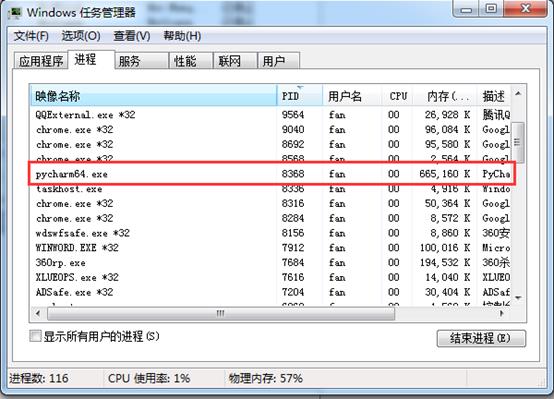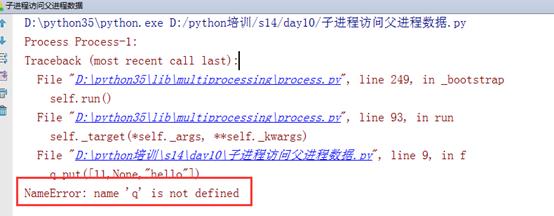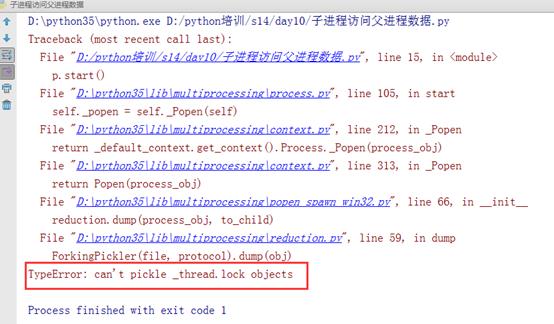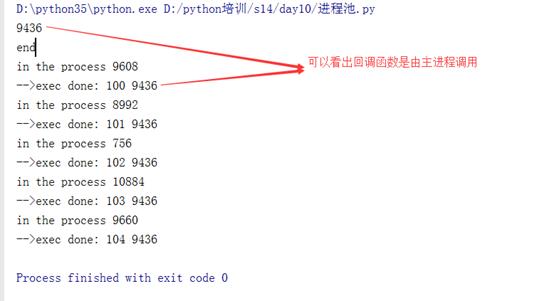多进程协程事件驱动及select poll epoll
Posted coder
tags:
篇首语:本文由小常识网(cha138.com)小编为大家整理,主要介绍了多进程协程事件驱动及select poll epoll相关的知识,希望对你有一定的参考价值。
目录
-多线程使用场景
-多进程
--简单的一个多进程例子
--进程间数据的交互实现方法
---通过Queues和Pipe可以实现进程间数据的传递,但是不能实现数据的共享
---Queues
---Pipe
---通过Manager可以不同进程间实现数据的共享
--进程同步,即进程锁
--进程池
-协程
--先用yield实现简单的协程
--Greenlet
--Gevent
--用协程gevent写一个简单并发爬网页
-事件驱动
--IO多路复用
---用户空间和内核空间
---文件描述符fd
---缓存IO
--IO模式
---阻塞I/O(blocking IO)
---非阻塞I/O
---I/O多路复用(IO multiplexing)
---异步I/O(asynchronous IO)
-关于select poll epoll
--select
--poll
--epoll
--以select方法为例子进行理解
多线程的使用场景
IO操作不占用CPU
计算占用cpu
python多线程不适合cpu密集型操作的任务,适合IO操作密集型的任务
多进程
简单的一个多进程例子:(用于理解对多线程方法的使用)
和线程的方法类似,下面是一个简单的多进程代码
1 #AUTHOR:FAN 2 import time,multiprocessing 3 4 def run(name): 5 time.sleep(2) 6 print("hello",name) 7 8 if __name__ =="__main__": 9 for i in range(6): 10 p = multiprocessing.Process(target=run,args=("dean",)) 11 p.start()
和之前学习的多线程结合在一起使用,代码如下:
1 #AUTHOR:FAN 2 3 import time,threading 4 import multiprocessing 5 6 def thread_run(): 7 print(threading.get_ident()) #这里表示获取线程id 8 9 10 def run(name): 11 time.sleep(2) 12 print("hello",name) 13 t=threading.Thread(target=thread_run) 14 t.start() 15 16 if __name__ =="__main__": 17 for i in range(6): 18 p = multiprocessing.Process(target=run,args=("dean",)) 19 p.start()
运行结果如下:

1 D:\\python35\\python.exe D:/python培训/s14/day10/进程与线程结合使用.py 2 hello dean 3 10008 4 hello dean 5 9276 6 hello dean 7 8096 8 hello dean 9 1308 10 hello dean 11 hello dean 12 10112 13 8032 14 15 Process finished with exit code 0
接着我们查看下面代码:
1 #AUTHOR:FAN 2 3 from multiprocessing import Process 4 import os 5 6 7 def info(title): 8 print(title) 9 print(\'module name:\', __name__) 10 print(\'parent process:\', os.getppid()) 11 print(\'process id:\', os.getpid()) 12 print("\\n\\n") 13 14 15 def f(name): 16 info(\'\\033[31;1mcalled from child process function f\\033[0m\') 17 print(\'hello\', name) 18 19 if __name__ == \'__main__\': 20 info(\'\\033[32;1mmain process line\\033[0m\')
运行结果如下:

1 D:\\python35\\python.exe D:/python培训/s14/day10/获取进程id.py 2 main process line 3 module name: __main__ 4 parent process: 8368 5 process id: 7664 6 7 8 9 10 Process finished with exit code 0
我们这里可以看到父进程id:8368,并且会发现无论程序运行多少次都是这个,然后我们在windows任务管理器查看发现这个是pycharm的进程id,如下图:

这里要记住:每一个子进程都是由父进程启动的
我们将上面代码中if __name__=”__main__”进行修改,如下:
1 if __name__ == \'__main__\': 2 info(\'\\033[32;1mmain process line\\033[0m\') 3 p = Process(target=f, args=(\'bob\',)) 4 p.start()
运行结果如下:

进程间数据的交互,实现方法
通过Queues和Pipe可以实现进程间数据的传递,但是不能实现数据的共享
不同进程间内存不是共享的,要想实现两个进程间的数据交换,有一下方法:
Queues
使用方法和threading里的queue使用差不多
先回忆一下线程之间的数据共享,通过下面代码理解:
1 #AUTHOR:FAN 2 import threading 3 import queue 4 5 def func(): 6 q.put([22,"dean",\'hello\']) 7 8 if __name__=="__main__": 9 q = queue.Queue() 10 t = threading.Thread(target=func) 11 t.start() 12 print(q.get(q))
运行结果:

1 D:\\python35\\python.exe D:/python培训/s14/day10/线程之间数据的共享.py 2 [22, \'dean\', \'hello\'] 3 4 Process finished with exit code 0
从上述代码可以看出线程之间的数据是共享的:父线程可以访问子线程放入的数据
如果是多进程之间呢?
将代码进行修改如下,让子进程调用父进程数据:
1 from multiprocessing import Process 2 import queue 3 4 5 6 def f(): 7 q.put([11,None,"hello"]) 8 9 10 if __name__=="__main__": 11 q = queue.Queue() 12 p = Process(target=f) 13 p.start() 14 print(q.get())
运行结果如下:

从这里我们也可以看出子进程是访问不到父进程的数据
我们再次将代码进行修改,写f方法的时候直接将q给线程传入,也就是,只有启动线程,就自动传入线程q,代码如下:
1 #AUTHOR:FAN 2 3 from multiprocessing import Process 4 import queue 5 6 7 def f(data): 8 data.put([11,None,"hello"]) 9 10 if __name__=="__main__": 11 q = queue.Queue() #切记这里是线程q 12 p = Process(target=f,args=(q,)) 13 p.start() 14 print(q.get())
运行结果如下:

这里我们需要知道:进程不能访问线程q
所以我们需要改成进程,代码如下:
1 #AUTHOR:FAN 2 3 from multiprocessing import Process,Queue 4 5 6 def f(data): 7 data.put([11,None,"hello"]) 8 9 if __name__=="__main__": 10 q = Queue() 这里的q是进程q 11 p = Process(target=f,args=(q,)) 12 p.start() 13 print(q.get())
运行结果如下:

1 D:\\python35\\python.exe D:/python培训/s14/day10/子进程访问父进程数据.py 2 [11, None, \'hello\'] 3 4 Process finished with exit code 0
这次我们就发现在父进程里就可以调用到子进程放入的数据
这里我们需要明白:这里的q其实是被克隆了一个q,然后将子线程序列化的内容传入的克隆q,然后再反序列化给q,从而实现了进程之间数据的传递
Pipe
实现代码例子:
1 #AUTHOR:FAN 2 3 from multiprocessing import Process,Pipe 4 5 def f(conn): 6 conn.send([22,None,"hello from child"]) 7 conn.send([22,None,"hello from child2"]) 8 print(conn.recv()) 9 conn.close() 10 11 if __name__=="__main__": 12 left_conn,right_conn = Pipe() 13 p = Process(target=f,args=(right_conn,)) 14 p.start() 15 print(left_conn.recv()) 16 print(left_conn.recv()) 17 left_conn.send("我是left_conn")
运行结果如下:

1 D:\\python35\\python.exe D:/python培训/s14/day10/通过pipes实现进程间数据传递.py 2 [22, None, \'hello from child\'] 3 [22, None, \'hello from child2\'] 4 我是left_conn 5 6 Process finished with exit code 0
对上面代码分析:pip()会生成两个值,上面的left_conn和right_conn,这就如同一条网线的两头,两头都可以发送和接收数据
通过Manager可以不同进程间实现数据的共享
通过下面代码进行理解:
1 #AUTHOR:FAN 2 from multiprocessing import Manager,Process 3 import os 4 5 def f(d,l): 6 d[1]="1" 7 d["2"] = 2 8 d[0.25] = None 9 l.append(os.getpid()) 10 print(l) 11 12 if __name__ == "__main__": 13 with Manager() as manager: #这种方式和直接manager=Manager()一样 14 d = manager.dict() #生成一个字典,可以在多个进程间共享 15 l = manager.list(range(5)) #生成一个列表,可以在多个进程间共享 16 p_list = [] 17 for i in range(10): 18 p = Process(target=f,args=(d,l)) 19 p.start() 20 p_list.append(p) 21 for res in p_list: 22 res.join() 23 24 print(d) 25 print(l)
运行结果如下:

1 D:\\python35\\python.exe D:/python培训/s14/day10/Manager实现进程间数据的共享.py 2 [0, 1, 2, 3, 4, 9756] 3 [0, 1, 2, 3, 4, 9756, 3352] 4 [0, 1, 2, 3, 4, 9756, 3352, 9220] 5 [0, 1, 2, 3, 4, 9756, 3352, 9220, 9736] 6 [0, 1, 2, 3, 4, 9756, 3352, 9220, 9736, 9724] 7 [0, 1, 2, 3, 4, 9756, 3352, 9220, 9736, 9724, 9860] 8 [0, 1, 2, 3, 4, 9756, 3352, 9220, 9736, 9724, 9860, 7084] 9 [0, 1, 2, 3, 4, 9756, 3352, 9220, 9736, 9724, 9860, 7084, 7452] 10 [0, 1, 2, 3, 4, 9756, 3352, 9220, 9736, 9724, 9860, 7084, 7452, 7376] 11 [0, 1, 2, 3, 4, 9756, 3352, 9220, 9736, 9724, 9860, 7084, 7452, 7376, 9952] 12 {0.25: None, 1: \'1\', \'2\': 2} 13 [0, 1, 2, 3, 4, 9756, 3352, 9220, 9736, 9724, 9860, 7084, 7452, 7376, 9952] 14 15 Process finished with exit code 0
通过结果可以看出已经实现了不同进程间数据的共享
进程同步,即进程锁
1 #AUTHOR:FAN 2 from multiprocessing import Process, Lock 3 4 5 def f(l, i): 6 l.acquire() 7 print(\'hello world\', i) 8 l.release() 9 10 if __name__ == \'__main__\': 11 lock = Lock() 12 for num in range(10): 13 Process(target=f, args=(lock, num)).start()
打印结果如下:

1 D:\\python35\\python.exe D:/python培训/s14/day10/进程锁.py 2 hello world 3 3 hello world 2 4 hello world 1 5 hello world 0 6 hello world 7 7 hello world 6 8 hello world 4 9 hello world 5 10 hello world 9 11 hello world 8 12 13 Process finished with exit code 0
可能会觉得这个加锁没有上面作用,其实是这样的,当在屏幕上打印这些内容的时候,不同进程之间是共享这个屏幕的,锁的作用在于当一个进程开始打印的时候,其他线程不能打印,从而防止打印乱内容
在windows上可能看不到效果,当不同进程打印的东西比较多的时候,就可以看到打印数据出现乱的情况
进程池
进程池内部维护一个进程序列,当使用时,则去进程池中获取一个进程,如果进程池序列中没有可供使用的进进程,那么程序就会等待,直到进程池中有可用进程为止。
进程池中有两个方法:
apply
apply_async(这个就表示异步)
从下面代码一点一点分析
1 #AUTHOR:FAN 2 3 from multiprocessing import Process, Pool 4 import time 5 import os 6 7 8 def Foo(i): 9 time.sleep(2) 10 print("in the process",os.getpid()) 11 return i + 100 12 13 14 def Bar(arg): 15 print(\'-->exec done:\', arg) 16 17 if __name__ == "__main__": 18 pool = Pool(5) 19 20 for i in range(10): 21 pool.apply(func=Foo, args=(i,)) 22 print(\'end\') 23 pool.close() 24 pool.join() # 进程池中进程执行完毕后再关闭,如果注释,那么程序直接关闭。
这样运行结果发现,程序变成了串行了。
将上述代码中的:
pool.apply(func=Foo, args=(i,))
替换为:
pool.apply_async(func=Foo,args=(i,))
之后就解决了之前的的问题
这个时候我们再次将
pool.apply_async(func=Foo,args=(i,))
替换为,这里的callback叫做回调函数
pool.apply_async(func=Foo, args=(i,), callback=Bar)
运行结果如下:

1 D:\\python35\\python.exe D:/python培训/s14/day10/进程池.py 2 end 3 in the process 10876 4 -->exec done: 100 5 in the process 5084 6 -->exec done: 101 7 in the process 9648 8 -->exec done: 102 9 in the process 11028 10 -->exec done: 103 11 in the process 8528 12 -->exec done: 104 13 in the process 10876 14 -->exec done: 105 15 in the process 5084 16 -->exec done: 106 17 in the process 9648 18 -->exec done: 107 19 in the process 11028 20 -->exec done: 108 21 in the process 8528 22 -->exec done: 109 23 24 Process finished with exit code 0
下面将代码进行修改,确定回调函数是由子进程还是主进程调用
1 #AUTHOR:FAN 2 3 from multiprocessing import Process, Pool 4 import time 5 import os 6 7 8 def Foo(i): 9 time.sleep(2) 10 print("in the process",os.getpid()) 11 return i + 100 12 13 14 def Bar(arg): 15 print(\'-->exec done:\', arg,os.getpid()) 16 17 if __name__ == "__main__": 18 pool = Pool(5) 19 print(os.getpid()) 20 for i in range(5): 21 pool.apply_async(func=Foo, args=(i,), callback=Bar) 22 #pool.apply(func=Foo, args=(i,)) 23 #pool.apply_async(func=Foo,args=(i,)) 24 25 print(\'end\') 26 pool.close() 27 pool.join() # 进程池中进程执行完毕后再关闭,如果注释,那么程序直接关闭。
运行结果如下,可以看出回调函数的pid和主进程是一样的

协程
协程,又称微线程,纤程。英文名Coroutine。一句话说明什么是线程:协程是一种用户态的轻量级线程。
协程拥有自己的寄存器上下文和栈。协程调度切换时,将寄存器上下文和栈保存到其他地方,在切回来的时候,恢复先前保存的寄存器上下文和栈。因此:
协程能保留上一次调用时的状态(即所有局部状态的一个特定组合),每次过程重入时,就相当于进入上一次调用的状态,换种说法:进入上一次离开时所处逻辑流的位置。
协程的好处:
无需线程上下文切换的开销
无需原子操作锁定及同步的开销
方便切换控制流,简化编程模型
高并发+高扩展性+低成本:一个CPU支持上万的协程都不是问题。所以很适合用于高并发处理。
缺点:
无法利用多核资源:协程的本质是个单线程,它不能同时将 单个CPU 的多个核用上,协程需要和进程配合才能运行在多CPU上.当然我们日常所编写的绝大部分应用都没有这个必要,除非是cpu密集型应用。
进行阻塞(Blocking)操作(如IO时)会阻塞掉整个程序
先用yield实现简单的协程
1 #AUTHOR:FAN 2 3 import time 4 import queue 5 6 7 def consumer(name): 8 print("--->starting eating baozi...") 9 while True: 10 new_baozi = yield 11 print("[%s] is eating baozi %s" % (name, new_baozi)) 12 time.sleep(1) 13 def producer(): 14 r = con.__next__() 15 r = con2.__next__() 16 n = 0 17 while n < 5: 18 n += 1 19 con.send(n) 20 con2.send(n) 21 print("\\033[32;1m[producer]\\033[0m is making baozi %s" % n) 22 if __name__ == \'__main__\': 23 con = consumer("c1") 24 con2 = consumer("c2") 25 p = producer()
运行结果如下:
